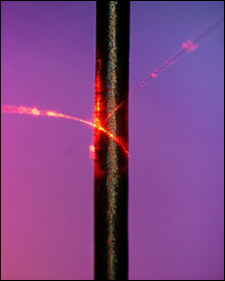Guiding the light fantastic on silica wire ‘rails’
Super-thin nanowires could yield optical chips, sensors for biological and chemical molecules

Marrying fiber optics with nanotechnology, scientists at Harvard University have created silica wires that are far narrower than the wavelength of light yet can still guide a light beam with great precision. The wires, about a thousandth the width of a human hair, function with minimal signal loss even when their walls accommodate well under half the breadth of a single light pulse.
A team led by Harvard’s Eric Mazur and Limin Tong, a visiting professor from Zhejiang University in China, reports the work in the Dec. 18 issue of the journal Nature.
“You wouldn’t normally imagine that a baseball could pass through a garden hose, but these nanowires appear able to handle exactly that kind of wide load,” says Mazur, Harvard College professor, Gordon McKay Professor of Applied Physics, and professor of physics. “In some cases light is propagating along wires just one-third the width of its own wavelength. It’s almost as if the wire serves as a rail to guide the light rather than funneling it in the traditional sense.”
The nanowires carry light via evanescent waves that envelop the slender filaments. If two of the wires touch, light can jump directly from one to the other, something that’s not possible with conventional fiber optics.
Although as thin as 50 nanometers, the wires created by Mazur and Tong are up to 2 centimeters long, making them faintly visible to the naked eye. They display impressive resilience and flexibility, curling easily into light-conducting loops whose diameter is just a tiny fraction of a millimeter.
The wires could aid in the development of optical chips that operate more rapidly and efficiently than today’s electronic chips. The tiny structures could also be used to manipulate cells and other microscopic objects. The wires are so fine that they could poke into a cell or a droplet of liquid without disrupting them, yet are extremely sturdy – several times stronger than spider silk, one of the gold standards in the world of materials.
Compared with ordinary fiber optic cable, which appears to the naked eye as a uniform glowing line, the wires created by Mazur and Tong have a beaded appearance when viewed under magnification. That’s because unlike a normal fiber, which confines light within its walls, minuscule particles of dust along the nanowires’ surface can scatter the light beam. Mazur and Tong say this sensitivity to surface contaminants could lead to use of the nanowires as molecular sensors.
“You could fit the surface of the wire with receptors for biological or chemical molecules,” Mazur says. “If those target molecules are present, they’ll attach to the receptors and you’ll see a strand of tiny lights shining when you launch light into the wires.”
While other researchers have tried stretching silicon wires to make them thinner, previous work has not yielded such uniform and smooth structures. Tong applied an ingenious technique to create the nanowires, wrapping a thicker silica wire around a sapphire taper that was held over a flame. As the wire reached temperatures of about 1,700 degrees Celsius, he drew it slowly along the taper, elongating and narrowing it. The resulting strands are not only ultrathin, but have a highly smooth surface and uniform composition.
Mazur and Tong’s co-authors on the Nature paper are Rafael R. Gattass, Jonathan B. Ashcom, Mengyan Shen, and Iva Maxwell at Harvard, and Sailing He and Jingyi Lou at Zhejiang University. Their work was supported by the National Science Foundation and the National Natural Science Foundation in China.




